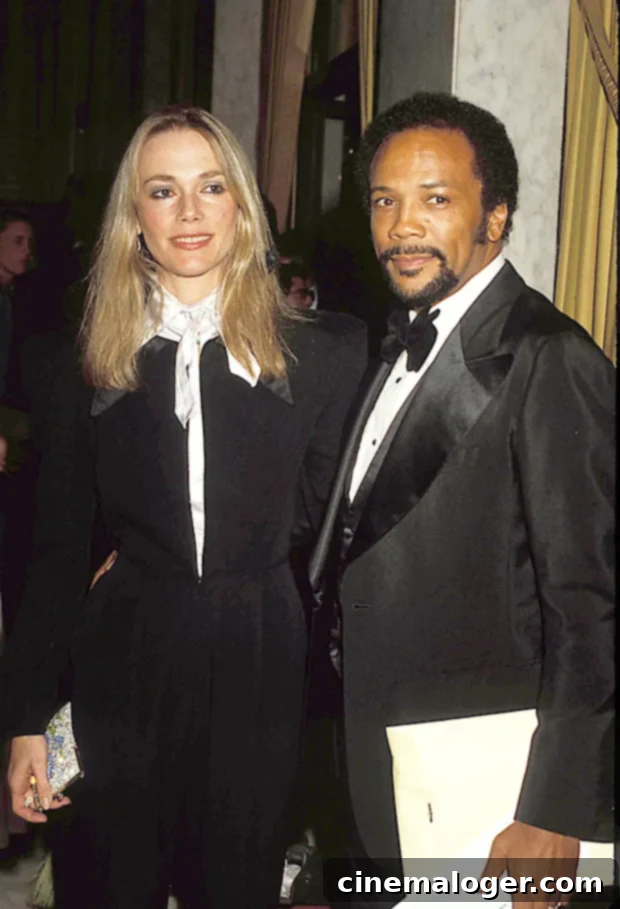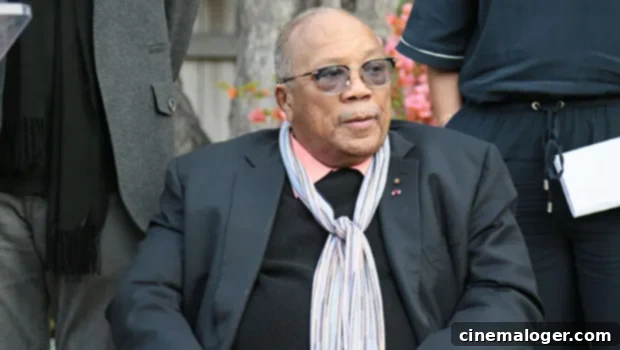Quincy Jones’ Wives: Exploring the Marriages and Family Life of a Music Icon
Quincy Jones, a name that reverberates through the annals of music history, forged an unparalleled career spanning over 60 years. Born in Chicago in 1933, this prolific artist rose from humble beginnings to become a titan of the music and film industries. His journey to stardom began after he left the prestigious Berklee College of Music in Boston to embark on a demanding touring career. By 1964, Jones made history, being named a vice president of Mercury Records – an unprecedented achievement as the first Black man to hold such a high-ranking position at a white-owned record company, as chronicled by the American Academy of Achievement.
His professional life was adorned with a staggering array of accolades: 28 Grammy Awards, a coveted Emmy, and seven Oscar nominations. Beyond the trophies, Jones’ impact is most profoundly felt through his collaborations with some of the biggest names in entertainment, from shaping Michael Jackson’s iconic sound to arranging for the legendary Frank Sinatra. Yet, beneath the veneer of professional triumph, Quincy Jones’ private life was equally rich and complex, marked by profound personal relationships.
Jones experienced the journey of marriage three times, and his relationships with various women brought seven children into his life. These women, each remarkable in their own right, held the key to the music industry icon’s heart during different chapters of his extraordinary life. This article delves into the stories of Quincy Jones’ three previous wives, exploring the dynamics of their relationships and the enduring family bonds they created.
Jeri Caldwell: The High School Sweetheart
Quincy Jones’ first foray into marriage was with actress Jeri Caldwell. Their romance began far from the bright lights of Hollywood, originating in the hallways of high school. Jones himself offered a charming glimpse into their early days during an interview with Oprah Winfrey. He humorously recounted how Jeri was the one to initiate their connection: “Jeri hit on me first. Back then I was dogging it up, and Jeri and her sister were the hotsy-totsies at school. I noticed that she stopped at the water fountain every day — the dog squad is real good at noticing patterns. My daughters have since taught me that guys think their rap is so strong that women can’t resist — but that’s not it: A girl has a guy spotted a year before he even knows she’s there!” This anecdote highlights the playful and authentic nature of their youthful courtship.
Quincy and Jeri tied the knot in 1957, when Jones was just 19 years old. Their marriage lasted nearly a decade, concluding in 1966. This period coincided with Jones’ formative years in the music industry, a time of relentless touring and burgeoning success that demanded immense dedication and time away from home. These intense professional demands undoubtedly put unique pressures on their young marriage. Together, they welcomed their daughter, Jolie Jones Levine, into the world. Jolie later carved out her own path as a successful model and singer, demonstrating artistic flair much like her parents. Jeri Caldwell herself has a notable acting credit, having appeared in the 1994 comedy Naked Gun 33 1/3: The Final Insult, showcasing her brief but memorable contribution to cinema.
Despite the dissolution of their marriage, Jones often spoke with respect about Jeri and their shared past. He candidly revealed that while Jeri was the first woman he married, she wasn’t his “first true love,” reflecting the evolving understanding of love and companionship that comes with youth and experience. Nonetheless, their union laid an important foundation in Jones’ life, leaving behind the cherished legacy of their daughter, Jolie, and a testament to the innocence and intensity of first loves.
Ulla Andersson: The European Muse
A year after his divorce from Jeri Caldwell, Quincy Jones embarked on his second marriage, uniting with Swedish model and actress Ulla Andersson. Their marriage, which began in 1967, spanned several years, culminating in their divorce in 1974. This period marked a transition for Jones, both personally and professionally, as he deepened his global reach. During their union, Quincy and Ulla expanded their family, welcoming a daughter, Martina Jones, and a son, Quincy Jones III. Quincy Jones III has notably followed in his father’s illustrious footsteps, establishing himself as a respected record producer, composer, and film producer, with a significant influence in the hip-hop genre. Martina, also known as Martina Jones Källberg, has pursued her own endeavors, often maintaining a more private profile than her famous family members.
Ulla Andersson was a successful and recognized figure long before her marriage to Quincy Jones. She gained considerable acclaim as a model, gracing the covers and pages of prestigious magazines across Europe. Her artistic talents, however, were not confined to modeling. Ulla also ventured into acting and, notably, explored a career in music. In 1979, she released her intriguing debut album, No Time No Space No Age No Race That’s Nifty!, which highlighted her adventurous and multi-faceted creative spirit. Decades later, Ulla offered a more personal reflection on her life and experiences through her 2007 autobiography, Red Carpet Blues. This memoir likely provides unique insights into her journey as a public figure, her artistic pursuits, and the complexities of her life, including her marriage to a global music icon.
Despite their shared creative endeavors and the joy of their children, the marriage between Quincy and Ulla proved to be relatively short-lived. The intense demands of Jones’ skyrocketing career and the inherent challenges of managing lives across continents may have contributed to the pressures on their relationship. Their divorce in 1974 marked another turning point, allowing Quincy to move forward and marry his third wife, Peggy Lipton. While their marriage concluded, the bond of family through their children endured, forming another crucial thread in the rich tapestry of Quincy Jones’ personal narrative.
Peggy Lipton: The Longest Union and Enduring Love
Peggy Lipton, an acclaimed American actress, model, and singer, renowned for her roles in groundbreaking television series like The Mod Squad and Twin Peaks, shared the longest marriage with Quincy Jones. Their relationship blossomed in the early 1970s, culminating in their marriage in 1974. By the time they exchanged vows, they had already welcomed their first daughter, Kidada Jones, into the world. Two years later, in 1976, their family grew with the birth of their second daughter, the highly successful actress, writer, and producer Rashida Jones.
Their marriage spanned 15 years, a significant chapter that concluded with their divorce in 1989. Beyond their personal connection, Quincy and Peggy became one of the most prominent and inspiring interracial couples of their time. Their union transcended societal expectations, becoming a symbol of love and acceptance that captivated the public eye. Peggy Lipton’s iconic role as Julie Barnes in The Mod Squad (1968-1973) earned her a Golden Globe Award and cemented her status as a counter-culture fashion icon. She later captivated audiences anew as Norma Jennings in David Lynch’s critically acclaimed mystery drama Twin Peaks (1990-1991, and its 2017 revival), showcasing her enduring talent.

The legacy of their marriage continues vibrantly through their talented daughters. Kidada Jones has carved out a successful career as a model, actress, and fashion designer, known for her unique aesthetic and collaborations. Rashida Jones has achieved widespread acclaim as an actress in beloved television series such as Parks and Recreation and The Office, and as a writer and producer for films like Celeste and Jesse Forever. Both daughters frequently speak with profound admiration for their parents, often highlighting the rich, diverse, and inspiring upbringing they received within a household that beautifully blended music, film, and fashion.
Despite their eventual divorce, the bond between Quincy and Peggy remained remarkably strong and respectful, forever cemented by their shared history and their beloved children. When Peggy Lipton passed away in May 2019, Quincy Jones expressed his deep sorrow and enduring love in a poignant Instagram tribute. “There is absolutely no combination of words that can express the sadness I feel after losing my beloved Peggy Lipton….My wife of 14 years,” he wrote, accompanying his message with a touching slideshow of cherished old photographs of them together. His heartfelt words resonated deeply with fans and colleagues alike.
He continued, “We shared many, many beautiful memories, & most importantly, we share two incredible daughters…Pie (@kidadajonesog) & Doonkie (@rashidajones). Regardless of the paths that our lives took us on, I can say with the utmost certainty, that love is eternal. Thank you all for the love & support you’ve shown me & my family.” These powerful words underscored a love that transcended the formal boundaries of marriage, evolving into an unbreakable familial bond and a testament to their lasting mutual respect, decades after their divorce.
Quincy Jones’ Later Life and Unconventional Philosophy on Relationships
In his later years, Quincy Jones remained as outspoken and captivating as ever, particularly when discussing his unique perspective on love and relationships. While he was not married at the time of his passing, his candid revelations about his romantic life frequently made headlines. In a revealing 2018 interview with GQ, Jones disclosed with characteristic frankness that he had 22 girlfriends, a statement that immediately garnered significant public attention and discussion. He then proceeded to list the diverse global origins of these partners, painting a vivid picture of a truly international romantic sphere: “Everywhere. Cape Town. Cairo. Stockholm — she’s coming in next week. Brazil — Belo Horizonte, São Paulo, and Rio. Shanghai — got a great girl over there from Shanghai, man. Cairo, whew,” he boasted, his words brimming with an undeniable charm and confidence.
What made this revelation particularly intriguing was Jones’ assertion that all his girlfriends were not only aware of each other but also accepted his unconventional arrangement. “I don’t lie. And it’s amazing — women get it, man,” he stated, challenging traditional notions of monogamy and relationships. He also shared a profound piece of wisdom, distilled from a lifetime of diverse experiences and connections: “Don’t you ever forget they’re 13 years smarter than we are. Don’t you ever forget it.” This statement reflected his deep admiration and respect for women, suggesting an appreciation for their emotional intelligence, intuition, and resilience that he believed often surpassed that of men.
This remarkably open and unconventional approach to relationships in his later life underscored Quincy Jones’ consistent refusal to conform to societal expectations, both professionally and personally. It highlighted a man who lived life on his own terms, constantly seeking connection, growth, and learning from every encounter. His candidness offered a rare glimpse into a private world that was as unique and vibrant as his storied professional career, solidifying his reputation as an extraordinary individual who embraced life’s complexities with unparalleled honesty, wit, and a distinctive philosophical outlook.
Quincy Jones’ three marriages to Jeri Caldwell, Ulla Andersson, and Peggy Lipton, alongside his candid revelations about his later relationships, collectively paint a comprehensive portrait of a man whose personal life was as rich and influential as his groundbreaking musical achievements. Each marriage marked a significant chapter, contributing children, shared moments, and invaluable lessons that shaped the legend he became. From the innocent high school romance to the transatlantic connection and the profound, enduring bond with Peggy Lipton, these relationships were integral to the tapestry of Quincy Jones’ life, reminding us that even the greatest public figures lead lives filled with deeply human connections and complex emotional landscapes, all contributing to their enduring legacy.
